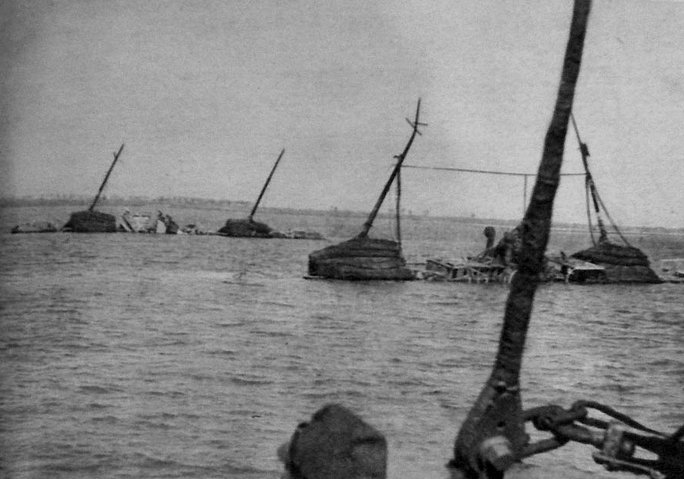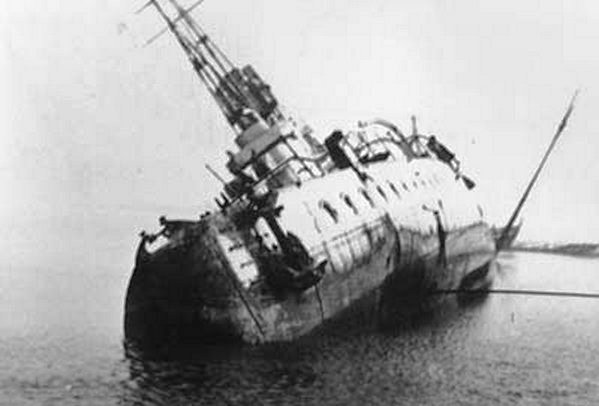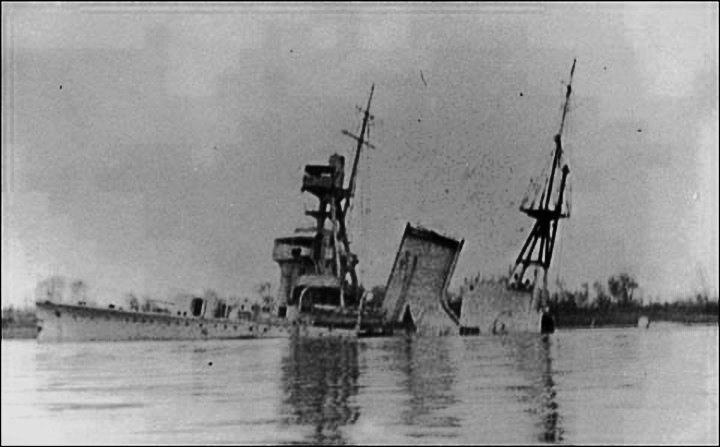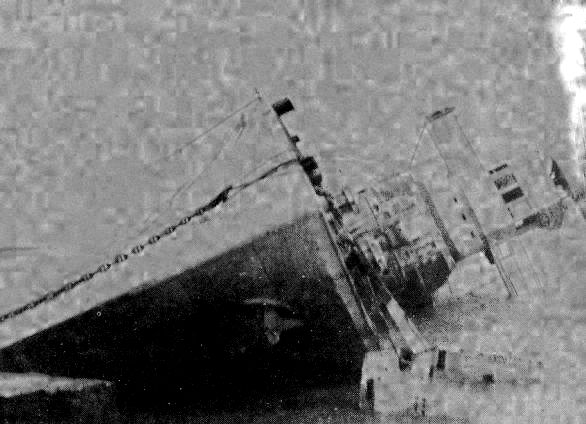RISING STORM - THE IMPERIAL JAPANESE NAVY AND
CHINA
1931-1941
 In one of history's most remarkable deliberate scuttlings, the Chinese
sink dozens of their own ships to block important rivers like the Yangtze as
the Battle for Shanghai rages. Some of the Chinese Fleet are among them. (Peter
Chen)
In one of history's most remarkable deliberate scuttlings, the Chinese
sink dozens of their own ships to block important rivers like the Yangtze as
the Battle for Shanghai rages. Some of the Chinese Fleet are among them. (Peter
Chen)
The IJN Destroys China's Fleet - August-September
1937
© 2012-2020 By Anthony Tully, Peter Chen, Bob Hackett and Sander
Kingsepp
Revision 1
August 1937:
Even as the Battle of Shanghai ratches up its tempo, the
Chinese Navy begins looking ahead, and seeking a means to thwart the Japanese
from moving further upriver into mainland China. Particularly on the agenda was
establishing some protection for Nanking's approaches.
7 August 1937:
Plans are drawn up to blockade the mouth of the Yangtze
River at Jiangsu Province.
11 August 1937:
Chinese trawlers GANLU, AORI and QINGTIAN with
assistence from gunboats SUINING and WEINING deploy teams to begin the first
stage of the task. Working furiously, they systematically destroy lighthouses,
buoys, and any other perceived navigations aids at the mouth of the Yangtze
River. It is hoped this will impair and otherwise complicate the anticipated
advance by the Japanese Navy. These measures continue despite Japanese air
attacks on Jiangyin area (Chiangyin in contemporary Western accounts),
downstream from Nanking.
12 August 1937:
The bulk of the main Chinese Central Naval Force, or
First Fleet, comprising cruisers HAIRONG, PING HAI, NING HAI, HAI CHOU and
YI XIAN (Western YI HSIEN or YAT SEN) along with training cruiser YING RUI
(YING JUI or YING SWEI) gather at the mouth of the Yangtze to guard against
Japanese naval incursions while the grand blockship operations begin. The
warships stand guard while eight older warships, twenty merchant ships and
eight barges are all deliberately scuttled and sunk in the river to serve
as blockships.
16 August 1937:
Six Mitsubishi G3M Type 96 "Nell" medium bombers
from the Kanoya Air Group strike the Jiangyin-Yangzhou area. The Chinese
Fleet suffers no notable damage, but with the blockships in place, it is
prudent to move further upstream.
31 August 1937:
A group of warships moves up to the next blockade
line at Jiangyin to defend the capital. Among them are flagship PING HAI with
sister-ship NING HAI, YI XIAN, and YING RUI.
14 September 1937:
Japanese light cruiser YUBARI is standing into
the Pearl River estuary with destroyers HAYATE and OITE. They encounter two
Chinese warships, the protected cruiser CHAO HO and the revenue cutter HAI
CHOW (ex-HMS PENTSTEMON), leaving Humen (Bocca Tigris) Strait. The result is
what might be the only surface action between the Chinese and the
Imperial Japanese Navy in the whole war. [1]
The Japanese squadron engages the Chinese vessels and the shore
batteries at the forts protecting the Humen Strait. Both Chinese ships are
damaged; HAI CHOW is hit three times and loses steering control. This causes
her for a short time to be heading directly at the Japanese fleet, as if on
a charge. Just as it seems the cutter will be blown out of the water, HAI
CHOU regains control. The more powerful CHAO HO inexplicably fights only
intermittently, and her captain soon orders a retreat. HAI CHOW manages to
escape upriver as well. Ironically, CHAO HO's leaving the battle does her
little good: she runs aground short time thereafter.
While returning to Taichang anchorage, the IJN squadron is attacked by
CAF Northrop A-17 attack bombers, scoring several near misses. Five sailors
from YUBARI are injured.
20 September 1937:
Vice Admiral (later Admiral) Oikawa Koshiro,
CinC, Third Fleet, orders carrier KAGA (CarDiv 2 Rear Admiral Horie Rokuro) and
land-based air of Rear Admiral Mitsunami Teizo's 2nd Combined Air Flotilla to
destroy the Chinese fleet. Oikawa particulary calls for the destruction of PING
HAI and NING HAI. The combined attack is to be launched in two days.
22 September 1937:
In the morning the combined Japanese assault to
destroy the Chinese fleet begins with KAGA launching her strikes from a position
off Hangchou Bay. At 1030 the first of three raids by 2nd Combined Air Flotilla's
12th Air Group (Captain Imamura Osamu) falls upon the ships. Twelve Kugisho B3Y1
Type 92 carrier attack bombers, escorted by six Nakajima A4N1 Type 95 carrier
fighters, attack first. They make high level bomb runs, concentrating on the two
big cruisers, but only score one hit on each and one near-miss with 60-kg bombs.
Flagship PING HAI is hit forward on the starboard side, causing slight flooding.
Her captain Gao Xianshen is badly wounded in the waist and left arm, but
continues to fight his ship until relieved. NING HAI receives one hit in the
bow. YI XIAN is also hit.
At noon, another wave of Japanese bombers comes in from the west and
drops bombs from moderate altitude. This causes minor damage to PING HAI. But
during the afternoon seven B3Y1 carrier attack bombers from KAGA attack, scoring
near misses with 30-kg bombs on both cruisers and a direct hit on PING HAI (at
1630). One hour later the last attack of the day is made by six B3Y1s of the
12th Air Group; after failing to locate PING HAI, they concentrate on YING RUI
instead, scoring four hits.
Despite six hours of combat, PING HAI's casualties are light; 5 killed
and 23 wounded. All in all she fires 265 8-cm rounds and more than 4,000 machine
gun rounds, claiming five Japanese aircraft shot down (none are lost). The
attacks for the day are over, and the Chinese Fleet survives the first round of
attacks. [2]
23 September 1937:
The Japanese follow-up raid takes its time in
coming. Morning brings no air raid, but at 1100 two Japanese recon planes are
sighted overflying the Chinese fleet. They depart after about a half-hour. It is
obvious that a large scale Japanese air attack will be inbound at last. All
hands clear for action.
At 1400, the expected attack arrives overhead in the form of nine B3Y1
carrier attack bombers, escorted by three A4N1 carrier fighters from 12th Air
Group, bombing Jiangyin to draw fire of the defenses while the second wave hits
the ships. This is comprised of twelve Aichi D1A1 Type 94 carrier bombers of the
12th Air Group, joined by fourteen Aichi D1A2 Type 96 "Susie" carrier bombers of
the 13th Air Group (Captain Senda Sadatoshi). These score two hits each and
several near-misses on both PING HAI and NING HAI. A last attack is made by
eight D1A1 and eight D1A2 bombers, escorted by four fighters from KAGA. These
attack in two waves and went after the primary target, the First Fleet flagship
PING HAI. They scored three hits with 60-kg bombs in the engine room and
magazine. This is more than the modest vessel can withstand; PING HAI settles
by the bow, and heeling over, bottoms with steep 45 degree port list and
forecastle awash. Reportedly just 5 were killed, with 50 wounded (remark: but
suspiciously, NING HAI also lists 5 killed). Four Japanese aircraft are claimed
shot down in turn.
With PING HAI down, the Japanese swarm over her cousin ship NING HAI. At
1400, as many as thirty-eight planes pounce on the small cruiser from three
directions. She receives two hits on the bow and observation post, and several
near-misses. Captain Chen Hongtai is wounded in the legs, but remains at post,
and gets his ship underway despite a magazine flooded. NING HAI moves upstream
away from her stranded sister, but she doesn't get very far before has to halt.
NING HAI has suffered 62 casualties of dead and injured, and has fired more than
700 8-cm and 5,000 machine gun rounds. Following the loss of PING HAI, the
injured CinC transfers his flag to YI XIAN.
 PING HAI, flagship of Gao Xianshen and the Chinese First Fleet, was
first damaged by air attacks on 22 September, then sunk in shallow water on 23
September by planes from KAGA. View from starboard quarter. Sister NING HAI
outlived her by only two more days. (Axis History)
25 September 1937:
PING HAI, flagship of Gao Xianshen and the Chinese First Fleet, was
first damaged by air attacks on 22 September, then sunk in shallow water on 23
September by planes from KAGA. View from starboard quarter. Sister NING HAI
outlived her by only two more days. (Axis History)
25 September 1937:
The hapless NING HAI outlasts her sister by only
forty-eight hours. Six B3Y1 carrier attack bombers with three A4N1 fighters
from the 12th Air Group make another attack on the Jiangyin area. Barely
afloat, NING HAI is helpless and unable to move. Two 60-kg direct hits and two
near misses are scored on the cruiser. This does for her, and listing slightly
to starboard, she settles by the stern 'til she bottoms upright near Bawei
Harbor with after deck submerged to the mainmast and base of the stack. Her
starboard beam parallels the nearby shore. Fortunately only five were wounded.
Attacked by sixteen planes from KAGA, Chen's new flagship, YI XIAN also goes
down. Beached in very shallow water, YI XIAN flops onto her port side and
settles with stern submerged and prow raised with a loss of 14 killed and 8
wounded. But the Japanese carrier lost two aircraft in exchange.
The Japanese had all but wiped out the Chinese fleet, but it was the
Chinese themselves that complete the destruction. The same day NING HAI is
finished off, four old cruisers are scuttled in the river: HAI CHI, HAI RONG,
HAI CHOU and HAI CHEN. It had not been intended to sacrifice all four cruisers;
however, incredibly, two of these had become blockships unwillingly.
Considering the fierce fight he had put up personally and losing his best ships,
First Fleet commander Chen Shaokuan demands that the other two cruisers not
belonging to the Min be scuttled as well! This is reluctantly agreed upon and
carried out. Before the ships are scuttled, some attempt is made that morning to
remove some of HAI RONG and HAI CHI's guns. Even hulks are put to use; at Humen,
cruiser CHAO HO, its guns having been stripped to arm the Shajiao Fortress, is
scuttled and capsizes onto her starboard side in shallow water. With this, the
fleet perished.
It was true that some isolated units yet remained in operation, but most of
these were hunted down by the Japanese in the days that followed with numbing
thoroughness. Chinese gunboat CHU YU at Jiangyin, damaged by air attack on the
28th is put down for good by Japanese aircraft on 29 September. Near the end of
the following month, on 23 October Japanese aircraft account for the last
holdout, the venerable training cruiser YING RUI also at Jiangyin. 20 killed
and 40 are wounded in this parthian sinking. Two months later, the Japanese Army
capture the city.
 NING HAI's wreck as found by the Japanese in December 1937. Crippled by
bombing on the 23rd when her sister went down, NING HAI crawled up river to off
Bawei Harbor, only to be sunk there on 25 September. (Author)
5 December 1937:
NING HAI's wreck as found by the Japanese in December 1937. Crippled by
bombing on the 23rd when her sister went down, NING HAI crawled up river to off
Bawei Harbor, only to be sunk there on 25 September. (Author)
5 December 1937:
In a strange aftermath, the two Chinese cruisers
both see new lives resurrected to serve their opponents. The Japanese army
advancing on Nanking takes possession of the bottomed Chinese cruisers NING HAI
and PING HAI, both sunk in shallow waters on the Yangtze near Koin. Both are
subsequently closely inspected and deemed salvageable.
2 March 1938:
PING HAI is first brought upright and then refloated
by the Japanese. Afterward, with the top portion of her bridge and director
removed, she is convoyed to Shanghai. Subsequently the partly stripped cruiser
is towed to Sasebo. The following month the Japanese made the first attempt to
refloat her sister, NING HAI. However two divers are killed working on the
wreck, delaying the works. Salvage soon resumes.
5 May 1938:
The wreck of NING HAI is successfully refloated; and when
pumped out is found there is minimal water damage to her vitals. She is taken
downstream to Shanghai's Kiangnan yard. Unlike PING HAI, the Japanese and
Chinese work crews manage to make NING HAI seaworthy to steam on her own power.
3 June 1938:
NING HAI arrives at Aioi, Japan with a Japanese crew.
There in Japan she remains idle with her sister for five years. NING HAI and
PING HAI Hai are now formally classified for Japanese service as coastal defense
vessels, being re-named MIKURA and MISHIMA respectively; however, they remain
idle at Aioi and Sasebo respectively 'til the changed war situation in 1943
compels their refitting as escorts YASOJIMA and ISOJIMA.
For more details of their careers in the Imperial Japanese Navy and their
final fates, see: ISOJIMA and YASOJIMA
 Last flagship of the First Fleet Chinese Navy, YIXIAN was sunk on the
same day as NING HAI. Here she lies capsized near Jiangyin.(Axis
History)
Last flagship of the First Fleet Chinese Navy, YIXIAN was sunk on the
same day as NING HAI. Here she lies capsized near Jiangyin.(Axis
History)
Authors' Notes:
[1] An encounter is also claimed for 14 July.
[2] LaCroix & Wells' Japanese Cruisers of the Pacific War
assigns this expenditure to both the 22nd and 23rd, but the Chinese sources
strongly indicate this refers only to Sept 22nd, placing it in the narrative at
the end of this day and before the events of the 23rd.
Special thanks go to Peter Chen for his translation of Chinese sources
and clarifications of nomenclature used therein.
Further Reading: An excellent website and link to Chinese Navy threads is
found at the following (particularly the thread "Actions of the Chinese
Nationalist Navy"):
Axis
History
Bob Hackett, Sander Kingsepp and Anthony Tully
Back to Rising Storm
Page








